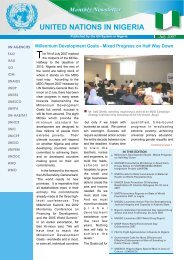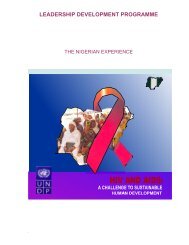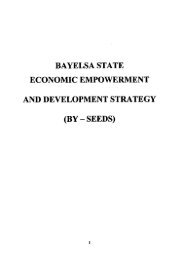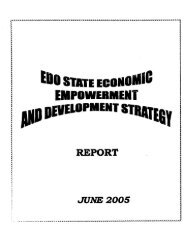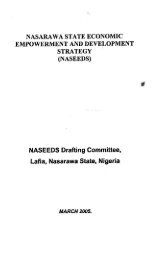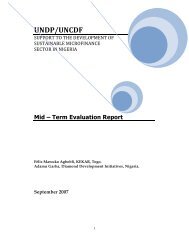Niger Delta Human Development Report - UNDP Nigeria - United ...
Niger Delta Human Development Report - UNDP Nigeria - United ...
Niger Delta Human Development Report - UNDP Nigeria - United ...
Create successful ePaper yourself
Turn your PDF publications into a flip-book with our unique Google optimized e-Paper software.
50<br />
works out at about 38 per 1,000. The<br />
growth in these land lines has stalled in the<br />
last few years, with the introduction of the<br />
global system of mobile communication.<br />
Due to this, <strong>Niger</strong>ia probably already exceeds<br />
the target for telephones. The <strong>Niger</strong><br />
<strong>Delta</strong> ratio is predicted to be better than<br />
<strong>Niger</strong>ia’s, perhaps being one per 20 people.<br />
The story is completely different with respect<br />
to the distribution of personal computers.<br />
<strong>Niger</strong>ia’s 2004 MDG <strong>Report</strong> estimates<br />
that the number of computers per<br />
1,000 persons remained at 4.1 in 1995 and<br />
1996, rising to 6.6 by 2000. The number<br />
of computers must have increased considerably<br />
by 2005, but no hard data support<br />
this.<br />
THE HUMAN DEVELOPMENT<br />
INDICES<br />
Given the social, economic and political<br />
conditions just described, it is of considerable<br />
interest to see how the <strong>Niger</strong> <strong>Delta</strong><br />
region fares on the human development<br />
indices. These include the human development<br />
index (HDI), the human poverty<br />
index for developing countries (HPI-1), the<br />
Elume Spill Fire<br />
human poverty index for selected countries<br />
in the Organisation for Economic Cooperation<br />
and <strong>Development</strong> (HPI-2), the<br />
gender-related development index (GDI)<br />
and the gender empowerment measure<br />
(GEM). Each of these is a composite index;<br />
many indicators go into their calculation<br />
(see boxes 2.3, 2.4 and 2.5 for the<br />
computations). The indices have been calculated<br />
for the nine states of the <strong>Niger</strong><br />
<strong>Delta</strong> as well as for the 185 local governments.<br />
In interpreting the results, it is important<br />
to note that the human development situation<br />
in <strong>Niger</strong>ia as a whole is deplorable.<br />
The use of relative terms—better, higher,<br />
worse and lower—should not be misconstrued.<br />
The mere fact that a region, state<br />
or local government has a higher score on<br />
an index than another does not necessarily<br />
mean that the human development situation<br />
in that region, state or locality is good.<br />
As will be clear in subsequent sections of<br />
this report, the HDI for the <strong>Niger</strong> <strong>Delta</strong><br />
region as a whole is unacceptable considering<br />
that it has produced the wealth fuelling<br />
development in other parts of the<br />
country.<br />
NIGER DELTA HUMAN DEVELOPMENT REPORT



